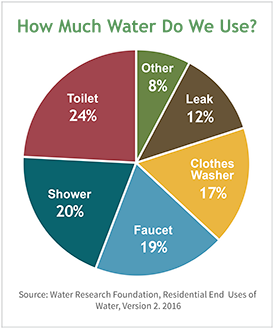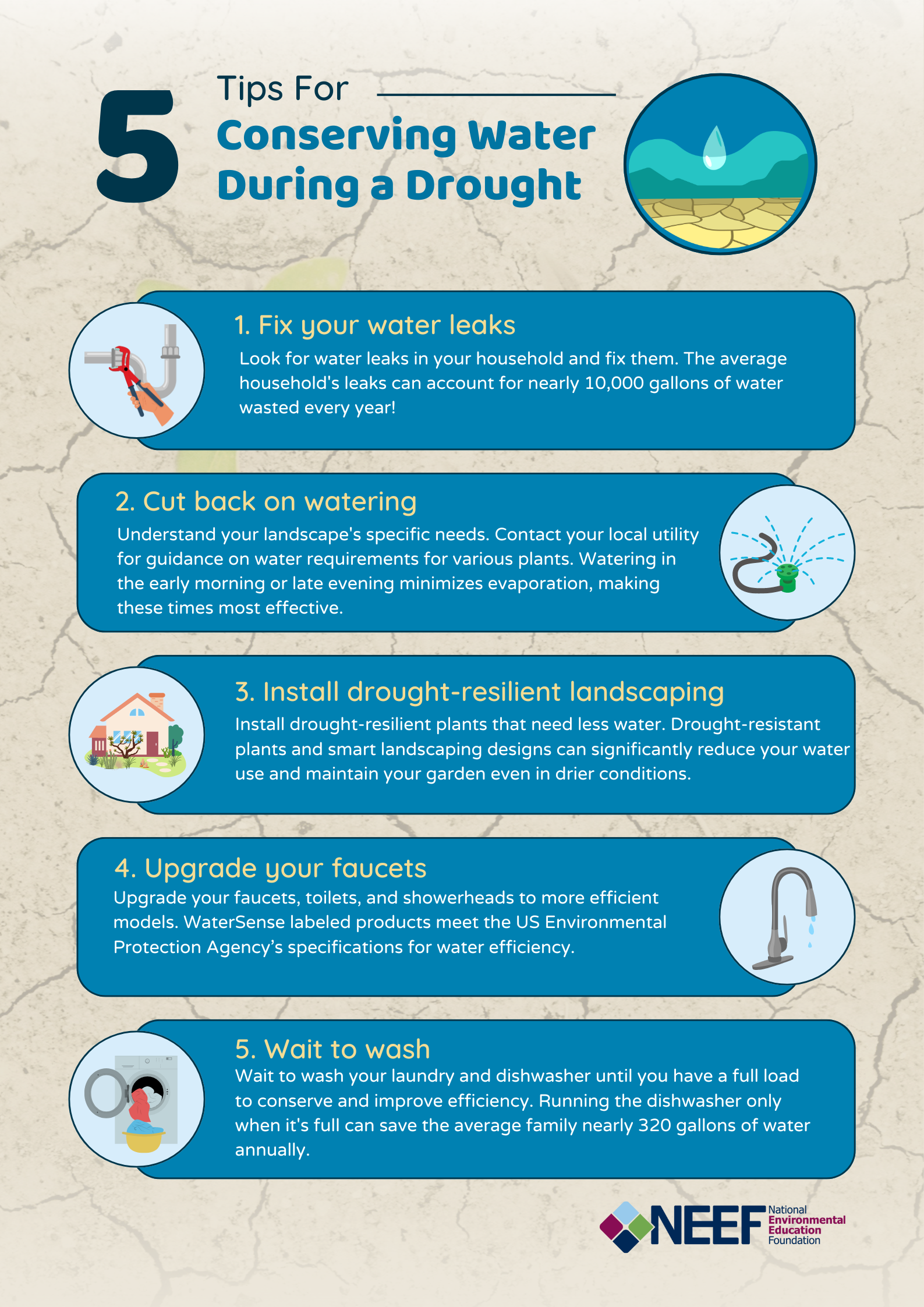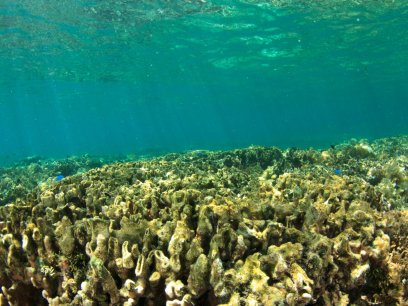
According to the most recent dataset from the US Geological Survey (USGS), total water use in the United States is approximately 322 billion gallons per day. Looking ahead, the demand for fresh water in many regions is likely to increase while supplies decrease due to a growing population, shifts in how land is used, and a changing climate. An assessment conducted by the US Forest Service found that nearly half of the 204 freshwater basins in the US may not be able to meet monthly water demand by 2071.
Water is an indispensable part of our daily lives. The average US family uses more than 300 gallons of water per day at home. About 70% of that water is used inside the home for things like flushing the toilet, showering, and washing dishes.

Fresh water is primarily used for thermoelectric power (45%), irrigation (32%), public supply (12%), self-supplied industrial (5%), and aquaculture (3%) in the United States. These water demands are expected to increase as temperatures increase and precipitation patterns change.
The Growing Demand for Water
As warmer temperatures increase the demand for water, the amount of fresh water available in some regions may decline, increasing competition for remaining water resources. For example, in a warming climate, increased rates of evaporation and melting snowpack will decrease the supply of fresh water in some US river systems and groundwater available for human use.
In the southern and eastern US, winter and spring are expected to bring more rain, increasing moisture when the ground is already wet. This can lead to more runoff and a higher risk of floods. At the same time, soils across the country are likely to dry out due to increased evaporation from warming temperatures, which underscores the complex and wide-ranging impacts that climate change brings.
Recent years have shown a dramatic increase in heavy rain events, particularly in the Northeast and Midwest, leading to more runoff and flooding. This has severely impacted urban and agricultural areas, similar to the effects of major droughts. From 1981 to 2016, these floods have been as damaging to crops as severe drought conditions.
Since 1980, droughts and associated heatwaves have caused approximately $328 billion in damages, straining water resources. Increased irrigation demands due to rising temperatures have put additional pressure on already declining groundwater supplies in major aquifers.
Climate change is already impacting one of the country’s most important water sources, the Colorado River Basin. Water use has significantly exceeded the natural flow of water through the river during a period of long-term drought and rising temperatures, depleting storage in the Lake Powell and Lake Mead reservoirs that provide water for urban and agricultural use across the Southwest.
A 2020 study by the USGS found that for every one degree Celsius rise in temperature, the Colorado River’s water flow has declined 9.3%, depleting 1.5 billion tons of water and counting. Modeling suggests water availability could drop 20-30% by 2050.
Looking forward, droughts are expected to become harsher and more frequent, especially in the Southwest. This will challenge the management of water resources. Adaptive strategies, such as enhancing reservoir operations and employing nature-based solutions, are crucial for mitigating the impacts of these changes and securing water supplies for the future.
Depletion of Groundwater in Major US Aquifers
Groundwater is a crucial component of our ecosystem, and its significance is immense. One-third of all Americans rely on groundwater for their drinking water, supplied by public water systems regulated by the US Environmental Protection Agency (EPA).
In key farming regions like California’s Central Valley, groundwater accounts for two-thirds or more of the irrigation supply during drought conditions. This overuse has resulted in falling water tables, drying wells, land subsidence, and the gradual vanishing of water sources. Nearly two decades of data from NASA’s GRACE satellite missions indicate a sharp increase in the rate of water depletion in the area since 2003.
Studies show that aquifers across the US are also diminishing. In places like Arizona and California, groundwater levels have fallen to their lowest in over two decades. Historical data indicates that since 1940, the number of wells with declining water levels has outnumbered those with rising levels every year.
Drought Impacts Water Availability in the West
Drought conditions occur somewhere in the US nearly every year. However, some years are much worse than others. In 2021, the West experienced one of the worst droughts on record.
The “megadrought” that gripped the southwest US for more than two decades is the driest 22-year period in at least 1,200 years. A megadrought is defined as a severe dry period lasting at least a couple of decades. An especially dry year in 2021 helped break that long standing record. The last megadrought known to be worse occurred in the late 1500s.
According to USGS, water withdrawals in four states—California, Texas, Idaho, and Florida—accounted for more than one-quarter of all water withdrawn in the United States in 2015. California alone accounted for 9% of the nation’s total water withdrawals at that time.

Disappearing Winter Snowpack’s Effects on Drought
In California and other arid western states, snowmelt is a crucial supply of fresh water during the drier summer and fall months. However, persistent drought conditions in recent years have highlighted the state's vulnerability to climate shifts.
The mountains of California deliver water through their snowpack. Snowpack refers to snow on the ground in mountainous areas that lingers into the warmer seasons. Diminished snowpack complicates California's ability to satisfy summer and fall water needs amid low rainfall and drought periods.
The 2022-2023 winter brought record rain and snow to the area, boosting hydropower generation prospects in the state. However, the Pacific Northwest experienced extreme heat and a dry summer with less-than-average precipitation, leading to a decidedly mixed water and hydropower outlook.
Water Efficiency Improves Conservation
Advancements in technology and strategic conservation measures have effectively reduced water usage in the United States, even amid rising population figures.
From 2005 to 2015, a significant decline in surface freshwater withdrawals was observed in 64% of counties, paralleled by a 10% drop in household water use, despite an 8% population increase. These improvements are thanks to technologies like low-flow toilets and community regulations that limit or remove nonessential turf.
Further, technological upgrades in agricultural irrigation and cooling systems for thermoelectric plants have decreased irrigation withdrawals by 7% and thermoelectric withdrawals by 34%. These adaptations are vital in addressing the challenges of water scarcity and recurrent droughts, showing the importance of efficient water management in maintaining societal resilience.
Learn How to Conserve Water During a Drought

It is always important to use water efficiently—but it’s absolutely critical during times of drought, and it will continue to get more important as we adapt to a changing climate. Prepare yourself by learning how to conserve water and how to make your home more drought resilient.
- Learn about drought and its impacts on society and the environment while gaining practical tips to save water with NEEF’s Dealing with Drought Online Course.
- Track which parts of the country are experiencing drought conditions using the US Drought Monitor, which is updated weekly.
- Look for water leaks in your household and fix them. The average household's leaks can account for nearly 10,000 gallons of water wasted every year!
- Cut back on watering your lawn. Sweep driveways, sidewalks, and steps rather than hosing them off.
- Wait to wash your laundry and dishwasher until you have a full load to conserve and improve efficiency. Running the dishwasher only when it's full can save the average family nearly 320 gallons of water.
- Install drought-resilient landscaping featuring plants that need less water. Even if your home doesn't have a sprinkler system, there are a number of simple steps you can take to promote a healthier lawn and garden with less water this summer.
- Upgrade your faucets, toilets, and showerheads to more efficient models. WaterSense labeled products are backed by independent, third-party certification and meet the US Environmental Protection Agency’s specifications for water efficiency and performance.


